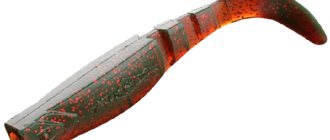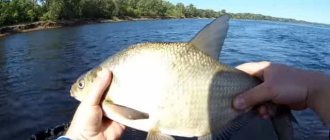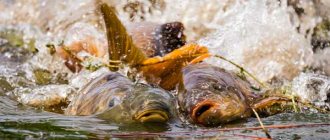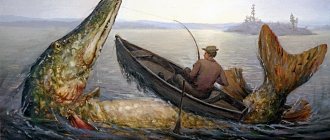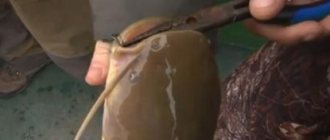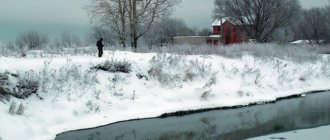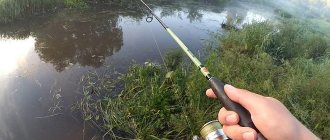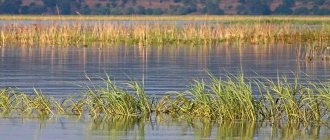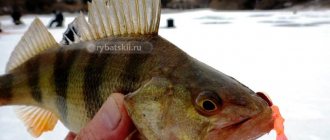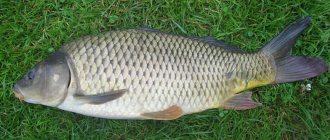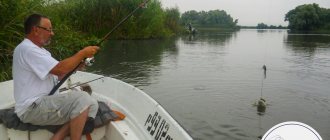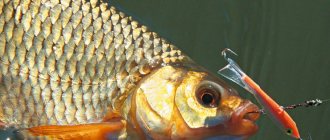Posts 1 page 30 of 314
Share12016-06-06 18:49:44
- Author: titan_lex
- Participant
- From: Novovoonezh
- Registered: 2016-01-25
- Posts: 326
- Respect: +726
Once again we visited the Don near Ilovlya (or rather Ozerki, they are closer). We stood in the same place, but we had to fish in a slightly different place. Last year's point was silent. The water level is very high, a little unclear. I had to fish from a cliff (5 meters). For the landing net, a rope was lowered to go down to the water. The main bait is maggot + corn. Predator on tails or bleak (only 4 pike perch were caught in the kilo area). Now I won’t look at the feeder for a month. Three days from morning to evening. There was a bite almost all day long. She simply overpowered Gustera, but the size is of course too small (a lot of them floated away to grow up). There was also a lot of lupach (also a bit small). Two specimens of sabrefish were caught, and 4 specimens of white bream (600-1000g). The crucian carp was on strike (about 4-5 pieces were caught). I was pleased that there were no vipers, not so much midges. The holiday was a great success. Five days of good fishing and excellent weather. The fish were salted and the captchas were brought. PS I was pleased with the M-6 highway. There is still a plot left in the Uryupinsk area, and some minor repairs are underway.
Share22016-06-11 18:01:29
- Author: Vovan Vovanych
- Club Member
- From: Maslovka gerbil
- Registered: 2015-12-23
- Posts: 8251
- Respect: +10297
I'll go there in July too
Share32016-07-03 21:08:21
- Author: Vovan Vovanych
- Club Member
- From: Maslovka gerbil
- Registered: 2015-12-23
- Posts: 8251
- Respect: +10297
Well, it's loaded, it starts at one o'clock in the morning. And a week of jig, well, sometimes troll, in general
Share42016-07-03 21:30:29
- Author: Bosyak
- Guest
Vovan Vovanych No tail, no scales!
Share52016-07-03 21:39:14
- Author: pavel35
- Active participant
- From: Left Bank
- Registered: 2016-01-09
- Posts: 954
- Respect: +1090
Vovan Vovanych We are waiting for the report!
Share62016-07-03 21:40:20
- Author: magnat277
- Veteran
- From: Voronezh, Lizyukova
- Registered: 2015-12-23
- Posts: 1152
- Respect: +1526
- Skype: dmitriy.radcevich
Share72016-07-03 21:40:42
- Author: Vovan Vovanych
- Club Member
- From: Maslovka gerbil
- Registered: 2015-12-23
- Posts: 8251
- Respect: +10297
Vovan Vovanych We are waiting for the report!
I'm not a writer
Share82016-07-03 21:41:37
- Author: Vovan Vovanych
- Club Member
- From: Maslovka gerbil
- Registered: 2015-12-23
- Posts: 8251
- Respect: +10297
Vovan Vovanych No tail, no scales!
Share92016-07-03 21:42:00
- Author: Vovan Vovanych
- Club Member
- From: Maslovka gerbil
- Registered: 2015-12-23
- Posts: 8251
- Respect: +10297
Share102016-07-03 21:48:30
- Author: pro-1975
- Club Council
- From: Voronezh, Northern, Temple
- Registered: 2015-12-23
- Posts: 9367
- Respect: +14110
Share112016-07-03 21:49:53
- Author: pro-1975
- Club Council
- From: Voronezh, Northern, Temple
- Registered: 2015-12-23
- Posts: 9367
- Respect: +14110
Vovan Vovanych , not a nail in the road and lots of impressions that you want to share. Waiting for you.
Share122016-07-03 21:54:00
- Author: Dyas
- Moderator
- From: b.Elektronika district
- Registered: 2015-12-21
- Posts: 7874
- Respect: +17742
I'm not a writer
Volodya, then only your camera will save you.
No tail.
Share132016-07-04 08:42:01
- Author: Sergey Zh.
- Club Council
- From: Otrozhka
- Registered: 2015-12-22
- Posts: 7469
- Respect: +15567
Vovan Vovanych Volodya, I think there is nothing more to wish for.
NHNCH.
Share142016-07-10 22:27:06
- Author: Vovan Vovanych
- Club Member
- From: Maslovka gerbil
- Registered: 2015-12-23
- Posts: 8251
- Respect: +10297
Share152016-07-10 22:28:27
- Author: Vovan Vovanych
- Club Member
- From: Maslovka gerbil
- Registered: 2015-12-23
- Posts: 8251
- Respect: +10297
The current arrived, dealt with the fish, report later.
Share162016-07-11 08:47:34
- Author: dds
- Veteran
- From: Voronezh, SW
- Registered: 2015-12-23
- Posts: 2491
- Respect: +2879
The current arrived, dealt with the fish, report later.
Don't languish.
Share172016-07-11 21:12:29
- Author: Vovan Vovanych
- Club Member
- From: Maslovka gerbil
- Registered: 2015-12-23
- Posts: 8251
- Respect: +10297
So, let's begin . We arrived on Monday, set up camp at 11, collected boats, gear, had a snack and started exploring. There is a lot of water, plus a meter and a half. We stood at the first point and there was a shock, the load was 32 g, there was no bottom, the load was 36, the same, I set it to 44, it worked (last year I caught a load of 22-24 here) the fence was 19. The first bites are indistinct, some kind of tingling, realizing that something needs to be changed, I put in another spool with braid 1 not (I don’t remember the name they gave for testing). The weight of the load dropped to 32 g and became a little more comfortable. While I was doing all these manipulations in the evening, the sudok came out, the bites were angry, the hooking was empty, the hooking was empty, no rubber, no fish. Meanwhile, the eldest, having rummaged through his backpack, puts on floating rubber (like John, probably) and 4 pike-perch in a row. In the morning we got up at 4 and there were bites on the water from 5 to 6'30. We took 6 pieces. At 7:30 on the shore we gut the fish for smoked fish and fish soup, and bai until 12. to be continued
Map of fishing spots
250 kg of fish for 1 fishing
Detained poachers told the secret of their success for a good bite. The fisheries inspectors were so surprised by their lack of poaching equipment.
The most promising and popular place for fishing in the region is the Volga floodplain - Akhtuba. The shore of the reservoir is almost completely open for fans of free fishing, but for those who like comfort, there are also specially organized bases that provide services on a paid basis.
The main part of the fishermen's catch is large roach and silver bream. Adherents of spinning fishing can hunt for pike and perch, which are caught quite well in the reservoir. Fishing places are located downstream, the lower, the more fish.
Summer fishing is considered the most successful in this region. It has been noticed that the peak of the bite occurs in the middle of summer. The hotter it gets outside, the more fish local fishermen manage to catch. At the end of summer, that is, in August, fishermen from all regions of the country come to have a great time on the shore of the reservoir and catch fish.
If you are going to fish at night, then you should take care of protection from midges, as there are a lot of them here.
You can fish on the reservoir from the shore or from a boat. It catches equally well, it all depends on your personal preferences and capabilities. Don’t forget to take care of the bait in advance, as it is sometimes impossible to buy it in local stores. The high influx of fishermen does not pass without leaving a trace.
News from the reservoir: Don River (Volgograd region)
Reservoirs of the Volgograd region have been updated:
Chir river
Fishing report: December 31, January 8, Don, river
Mormyshka. Catch:
more than 10 kilograms
Fishing location: from the confluence of the Khopr into the Don, to the Bear
7:30 is the time to get up. It's just starting to get light outside, and there's only half an hour before breakfast. A pinch of bloodworms and maggots in a box, today we will check Khoper and Don for fishing for white fish. Dress warmly; today we will travel by snowmobile. Temperature -23, light wind, dawn outside, hearty breakfast, thermos under the snowmobile seat and off we go! There are gullies on the Don, so we decide to move along the shallows and the shore. We cross the Don along a proven, well-worn local road. On the left bank of the Don there are 5-6 fishermen sitting near a snag, they go out every day to the same place since the New Year, they fish with fishing rods and feeders, the current here is strong, you can’t reach the bottom with any jig. We approach (point 1 on the map), there are a couple of Glazunov (white-eye) and several Kalinka (blue) as big as a palm lying on the snow, but this is cover. They actually sit and catch fish and shemai. We are leaving, I don’t like fishing with a feeder, I would like to shake a jig, even a LARGE one :-).
The first goal of the trip is to return to Khopra at the entrance to the oxbow lake (point 2 on the map). The road runs through the Nizhne-Khopersky Natural Park, through dozens of floodplain lakes. There has been no serious flood on the Don for two years, so the lakes are populated mainly by perch and pike. We decide not to stop, we’ll leave them for later if there’s no bite in the river. Around nine o'clock in the treasured place, in the summer pike perch is caught here, and the jig head often dances on the backs of white fish. Roughly imagining how a stream flows under the ice, I drill holes along the edge of the current and the return line, about 5 of them at once. The first hole, there’s a bite right away, a bluefish as big as the palm of your hand, there’s practically no current. I had to wait about 3 minutes for the second bite. I change holes, the picture is similar. No, this is not the kind of fishing I was expecting. Opposite the entrance to the bay, already on the driftwood current, a couple of dozen jig heads are left there in the summer. Now there is a hummock above the snag; the ice floe, broken off during the freeze-up, has rested against the snag. I drill a meter below the hummock, the water in the hole is light, this is good, often behind the hummock, under the ice, there is all sorts of debris - leaves, pieces of trees, crumbs of ice mixed with sand. The current here is strong, the tungsten jig is 15 grams. At the first touch to the bottom there is a bite, after a short pull, a good bluegill is 300 grams. A new portion of bloodworm, touching the bottom, a couple of lifts and the result is repeated. The hole is working - there is an active bite throughout the entire fishing period, a strong current complicates things a little, after pulling out the fish and touching the bottom again, up to 5 meters of fishing line remains on the snow. I drill a few more holes, the bite is bad in calm water, the fish is standing in the current. A hundred meters downstream, locals sat down and often waved their hands, naturally I was interested. I come closer, continuing to drill holes and catch. They catch in a strong stream, on feeders, and the fish are smaller than mine. I return to my catch point. At the next bite there is strong resistance, the fishing is no longer so calm, and you have to cover the hole with a hat, well, the fish doesn’t come to light. Everything ends in my favor, a good fisherman is caught. The hole also pleases with a good bream, 600 grams. The feeling of hunger makes you look at the clock - 14:30, at 17:00 it’s already dark, there are still so many plans. We collect the fish in a large METRO bag))) we caught it normally... We quickly had lunch on the shore, by the fire built by the huntsman, sandwiches and tea. We change the location. The exit from a deep hole (point 3 on the map, in summer the hole is up to 12 meters deep), old holes are drilled along the left bank - it’s quiet. In total I drilled about a dozen holes. Basically, one hole - one fish. Under the right, steep bank, a minnow comes across. One hole pleases with the heel of weevil ruffs, large ones at that, how good they are in the ear! For everything about 30-40 minutes, you need to check the confluence of Khopr and Don before dark. While fishing on Khopr, we were convinced of the strength of the ice, so we “bravely” drove along Khopr itself. Feel free to put it in parentheses, because on the fast current of the Khopr you can never be completely sure of the strength of the ice, even in thirty-degree frost. The point marked on the map as 4 is a favorite fishing spot, both in summer and winter. The place is loved not only by fishermen, but also by fish! There are a lot of white fish, and pike perch are actively chasing them here. What kind of bream were there last year, no, not like that - Bream, not like that again - BREAM! This year, large bream did not come here, the river is changeable, which makes fishing on it interesting. The first hole is at the very confluence, a little to the right of the riverbed there is shallow watering with an alternating current. Yesterday it caught white fish well, and in the evening a pike perch came out, it came out well. And there was a pike yesterday, I still have a pleasant memory of trying to pull it out, but that time the fight ended in its favor, it bit off the Rappal balancer under the perch. But that was yesterday, and today white fish regularly take bloodworms, but the pike perch does not respond to the balancer, probably it did not have an evening out. But God bless him, there is still a favorite place on the right bank that needs to be checked, and there are only a few minutes before darkness. My favorite place also turned out to be working and pleased me with another good fish. It got dark, we headed home, but after two hundred meters (point 5 on the map) we met a vacationer from the base, in his hands was a package, with a Tail sticking out of the package. The tail turned out to be a pike, it looked like a 3-plus keel, there was still some in the bag! There was a two-kilogram pike perch and a smaller pike perch, another pike, and there were also, but no longer in the bag, five hits and a pike that won the duel with the fisherman, all bites from 14:00 to 17:00. “Excellent Andrey,” this is said out loud, but to himself “So there was no way for you to get out of the pike perch!” On my way back, I meet local acquaintances coming from the bay near the base (point 6 on the map), I’m interested in the catch - they show me the bag - there are a lot of small roach, palm-sized bream and perches. The result for the bay is predictable.
Features of fishing on the Don
In winter - it is not always winter that there is ice on the Don. But if it does, they catch it with winter fishing rods, girders, and nods. They use winter fishing rods to catch ram, bream, and crucian carp. Perch and pike perch are caught using spinners and balancers, but you need to look for them properly and then the bite will not take long to come.
In the spring , in most cases there is a spawning ban on fishing on the Don. They are mainly caught using float rods and spinning rods from the shore. At the beginning of May, the Azov herring begins to move, which is caught from Azov to Tsimlyansk using specialized marine equipment.
In summer - due to the high temperatures in the summer in the Rostov region, they are caught mainly in the early morning and evening, using float rods, feeders, donks and spinning tackle. Fish can be caught almost along the entire length of the river. The fishing spot is chosen according to the fisherman’s landscape preferences and the desire to catch this or that type of fish.
In autumn , the predator becomes more active and is caught on spinning rods, using spinners, wobblers, and silicone. The perch begins to prepare for winter and flock together. If you find such a flock, then fishing will be guaranteed. In the depths, pike perch can be caught well with twisters and pike in shallow water with surface wobblers and spinners. From the shore they are not bad at catching pelengas.
Chapter 2. Comprehensive study of the Ilovlya River section
I believe that the study of a small river is necessary because... As a result of the study, new hydrographic, hydrochemical and hydrobiological characteristics of the river that have formed to date are identified.
Physiographic characteristics of the Ilovlya River
The Ilovlya River flows along our village (Appendix 2) . On the Internet I found information about the origin of the name of the river and interesting historical facts. According to one version, the name of the river is associated with the word “silt” and means “river with a soft muddy bottom.” From the middle of the 18th century. fugitives (former serfs) settled on the banks of the river. One of the legends explains the name of the river by the fact that here the king’s envoys caught runaway people. The first mentions of the river are found in historical documents of the 17th century in connection with the construction of fortifications along Ilovlya and Don. In the Kamyshin area, Ilovlya comes so close to the Volga that in ancient times even ships were dragged from one river to another. This section was called “transportation”. Tsar Peter I planned to build a canal in this place to connect both rivers, but this was not destined to happen. Today you can see a ditch and an earthen rampart, which indicate the seriousness of Peter the Great's intentions. The village located nearby is called Petrov Val. It was on the Ilovlya River that the artist Petrov-Vodkin painted the famous painting “The Bathing of the Red Horse” ( Appendix 3 ).
Having studied the topographic map, I determined that the river originates within the Volga Upland near the village of Pervomaiskoe ( Appendix 4 ). The river first heads south and then turns southwest. Ilovlya flows into the Don, being its left tributary. The river flows through the territory of the Krasnoarmeysky district of the Saratov region and through the territory of the Volgograd region. I learned that the length of the river is 358 km, the basin area is 9250 km2.
Based on many years of observations of village residents and my own observations, I came to the conclusion that Ilovlya is a typical flat steppe river with a smooth flow of water. The length of the river flowing near the village is about 3 km. The channel is winding, from a meter to 15 m wide. The flow speed is low. The river is characterized by spring floods, summer-autumn low water, interrupted 2-3 times a season by rain tides, and persistent winter low water, when it switches to groundwater feeding. The freezing of the river (the beginning of freeze-up) occurs at the end of November - beginning of December. It is covered with ice until the beginning of April. There is no ice drift, because ice freezes to the coastal bushes. Ilovlya receives its main nutrition from melting snow, as well as rain and groundwater, and is also replenished by a tributary: the Kamenka River (left tributary), which flows through our village. During the spring flood, the water in Ilovlya rises by more than three meters (in years with snow), and the river spills widely across the plain. However, in summer, especially in dry years, the water level drops significantly. The river becomes shallow, at some points the depth is 0.2 m.
Determination of water quality
I determined the water quality in the Ilovlya River; for this I took water samples. To characterize the quality of water, I determined the hardness of the water, the nature and intensity of the odor of the water, the color and turbidity of the river water (Appendix 5).
Determination of water hardness
To do this, a concentrated soda solution was gradually added dropwise to 100 ml of sample. Visually noted the amount of sediment that fell. A lot of sediment means hard water, little sediment means moderately hard water, practically no sediment means soft water. .
Determination of the nature and intensity of the odor of water
I determined the smell of water by vigorously shaking the water in a test tube closed with a stopper. After removing the plug, I determined the intensity and nature of the odor by smell. I checked my perception with the scale (Appendix 6).
Definition of color
To determine the color, I filtered the test water through a paper filter. I compared the color of the water with the color of the same volume of distilled water over a sheet of clean white paper. Iron salts and humic acids give the water a yellow color. The greenish color of the water may be associated with the phenomenon of eutrophication, i.e. oversaturation with nutrients, and as a result, the presence of microscopic algae.
Determination of water turbidity
The content of insoluble impurities can be determined by eye: very cloudy, cloudy, transparent, by examining the water in a test tube against a white screen.
I entered the results of the water quality study into a table.
| No. | Water quality indicators | Conclusion about quality |
| 1 | Smell | Mixed, predominantly silty with an admixture of the smell of rottenness. Slightly noticeable. Presumably the smell is associated with organic decay products. |
| 2 | Color | The water is slightly turbid, greenish in color, which presumably proves the connection with the oversaturation of nutrients. |
| 3 | Rigidity | The water is soft |
Animal and plant life
I have compiled a list of the composition of flora and fauna. Moisture-loving plants grow along the banks of the river: cattails, reeds, sedges. Trees grow along the entire coast: willows, willows, willows, alders (Appendix 7). Coastal trees, reeds, and cattails help rivers become cleaner; they remove nitrates and other harmful substances from the water with their roots. The river contains fish: crucian carp, roach, chub, perch, pike, rudd; muskrats live in the coastal zone (Appendix 8 ). In two sections of the river I saw traces of beavers (Appendix 9). Wild ducks live in the thickets along the banks. It was interesting for me to observe the life of swimming beetles, dragonfly larvae, and water striders. All the inhabitants of the reservoir are connected with each other. If there are few bacteria in the water, there will not be many ciliates and rotifers on which mosquito larvae feed. There is no prey for predators - there are few predators: beetles, water bugs, dragonfly larvae. In the water, invertebrates are constantly working to make it cleaner. Beetles and larvae of various insects destroy sick animals and their corpses, preventing the occurrence of epidemics. Mosquito larvae eat various rotting debris.
